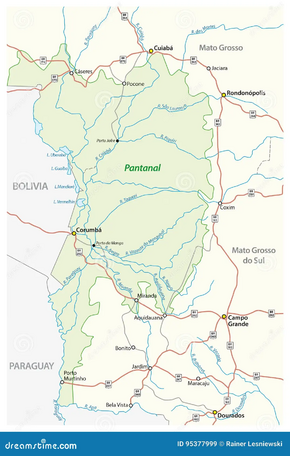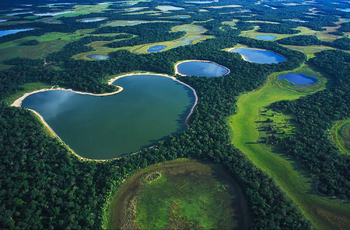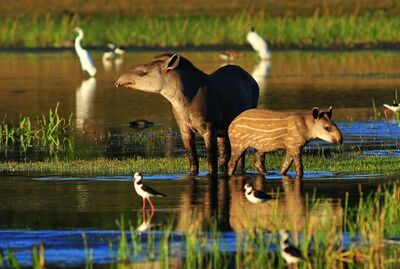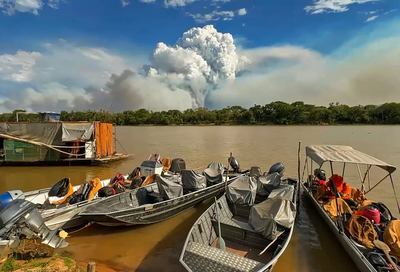Course:CONS200/2023WT2/The world's largest floodplain: The Pantanal
By Jeeyanshi, Viya Kotwal, CJ and Prabhjeet
Introduction: The Pantanal
Location
The Pantanal, situated in the upper Paraguay River Basin, stands as one of the world's largest floodplain wetlands, encompassing over 150,000 km2 of land and renowned for its rich biodiversity and ecological significance[1]. The region's unique hydrological cycle, characterized by annual flooding from the upper Paraguay River and its tributaries, supports diverse ecosystems ranging from floodplain forests to open savannas[1]. 'The upper Paraguay River catchment area covers about 496,000 km2 , the Pantanal about 160,000 km2 , of which about 140,000 km2 belong to Brazil, 15,000 km2 to Bolivia and 5,000 km2 to Paraguay' [2].
Hydrological characteristics
The Pantanal is a biome characterised by extreme fluctuations of humidity, which makes it a wetland. It is also an immense syncline, where rivers, lakes and wetlands are intersecting with the terrestrial ecosystems while in a constant dynamic change state[3]. The Ramsar convention promotes the wise and sustainable use of wetlands, and the Pantanal has three Ramsar sites. Waterfowl habitat: the Pantanal Matogrossense National Park, SESC Pantanal Private Reserve and the Negro River Private Reserve. This region contains very rich biodiversity and a large variety of plant and animal species, who are also endangered and are at risk of complete extinction. For example, the large blue macaw (Anodorhynchus hyacinthinus), the giant otter (Pteronura brasiliensis), the jaguar (Panthera onca) and the marsh deer (Blastocerus dichotomus) are some endangered species that can still be seen easily in the Pantanal. The Indigenous Peoples, ‘Pantaneiros’ are an important part of the ecosystem there. Their livelihood depends on the environmental health of the wetland, but they also help the land in many ways[4]
‘The floodplain also functions as a large ‘reservoir’ that stores water from the plateau during the rainy season and delivers it slowly to the lower sections of the Paraguay River, buffering the magnitude of the floods’. The rainy season although, begins between September and December, and increases between January and March. This encourages the flood wave movement from the north through the south Pantanal, immersing almost 70% of the floodplain until July. Significant portions of the Pantanal floodplain are submerged from four to eight months each year by water depths from a few centimetres to more than two meters.[4]
Over the last few decades, there has been increasing pressure being put on the Pantanal by the governments of Brazil, Bolivia and Paraguay, to invlove it in national economic development. The development projects aim to improve living conditions and stimulate economic growth, although resulting in widespread and far reaching consequences, that are still not completely identified, making the issue worse. [5]


Background: The problems
Anthropogenic activities are causing the degradation and loss of wetlands at an extremely rapid pace, particularly faster than any other ecosystem. This is critical for the status of freshwater wetland species and the other plants and animals habiting there. ‘The disruption of the structure and functioning of an ecosystem, such as water flow, matter and energy transfer, production and decomposition processes (nutrient cycling) can have dire consequences for nature and society’ [4].
In the Mid-1970s, the Brazilian government started several large development programs like the, the Program for the Development of the Pantanal (PRODEPAN), the Program for the Development of the Cerrados (POLOCENTRO), the National Alcohol Program (PROÁLCOOL), and many more. These programs aimed to intensify the utilization of natural resources its catchment area and to integrate the region into the national development scheme, for instance, by the construction of roads and lines for electric energy transmission.[5] The agroindustrial development brought about numerous problems, massive economic pressure was put on traditional ranches, to increase beef production. This is impacting the ecosystem in many ways, like deforestation increases, overgrazing which leads to soil degradation and also plantation of artifical pastures.
Even though sustainable development should be reached in the Pantanal according to many, what exactly is described as sustainable? The term “sustainable” was defined by the Consultative Group on International Agricultural Research (CGIAR) as the “successful management of resources for agriculture to satisfy changing human needs while maintaining or enhancing the quality of the environment and conserving natural resources”[5] This approach clearly is from an anthropocentric view, which looks to 'use' nature for human purposes and needs, without putting the health of the environment that sustains us first.
Anthropogenic influence
The most important economic activities within the Pantanal include cattle ranching, commercial and sport fishing, and eco-tourism. Over the past 25 years, a significant area of the upland basin has been transformed from natural cerrado savanna to managed grazing or intensive agriculture, significantly increasing the rate of erosion. The Pantanal has many regions that are entirely devoid of trees. Numerous anecdotal reports indicate that river sedimentation has decreased fish populations and rendered the rivers less navigable. It appears that the Taquari, Piquiri, and São Lourenço river systems are particularly affected. When it comes to the Taquari basin, pasture-used regions clearly experience more severe soil erosion than areas converted to row-crop agriculture. The Taquari River fan has experienced significant variations in the distribution of flooding in recent decades due to sporadic shifts in the river's course, which may be connected to the river's increased sediment load. The construction of raised roads in the Pantanal can have detrimental ecological effects; as recently as 1981–1983, plans for regional growth called for the construction of a vast network of about 800 km of roads inside the Pantanal. Raised roadways not only improve accessibility to the area but also frequently change the natural hydrological flow patterns during flooding, especially if they don't follow the direction of the water flow. The water level differential between the upstream and downstream sides of roadways is frequently apparent, even in the absence of culverts or bridges, and eventually the vegetation may show changes. Reduced flow of flood-plain waters results in a lower supply of nutrients and a higher likelihood of oxygen depletion, especially in areas where dissolved oxygen concentrations are normally low. However, for aquatic and terrestrial fauna during the dry season, the numerous borrow pits made during the construction of higher highways can represent significant permanent water bodies. There are advantages and disadvantages to wildlife being drawn to areas near highways. While tourists can observe the creatures more easily, they are also more vulnerable to being killed by cars and poached.[6]



What is being done?
Compared to all other areas, the Pantanal is considered to be the most preserved. Even though this is the case, only 2% of the areas is protected by governments. To increase this number, programs such as the WWF are expanding protected areas and promoting the use of sustainable resources. The WWF Bolivia Pantanal programme is an example of solutions that are being made to fix the problems mentioned above. The main objective of the Pantanal program is to maintain the hydrobiological processes. Particularly, the ones that result in sustainable development as well as environmental management. They are also determined to put an end to all the degrading land uses that has been happening in areas such as the Pantanal. Furthermore, this program has the goal to minimize disruptive infrastructure that is negatively effecting the Panatela. This includes practices that are related to roads, railways, dams, etc. This program has dedicated it's time to identifying the impacts of land development and what changes need to happen in order to maintain this wetland.
Many countries, including Brazil, Bolivia and Paraguay are participating in efforts to save the Pantanal. This attempt to save the Pantanal is known as the Trinational Initiative which is dedicated to sustainably developing the world's largest wetland. It is an effort that has goals to significantly progress the conservation in areas such as the Pantanal. This initiative aims for these three countries to have a similar approach to the problems the Pantanal is facing. The main goal is to implement sustainable practices in the area while allowing environmental benefits for all of nature. Some accomplishments that have been made include, the three countries partnering with non government agencies, conducting research that identifies the pressures faced by the Pantanal, as well as strategies to address the problems. The countries have created a five year plan to solve all problems noted in the Pantanal.
Interference with the Patanals waterways causes negative consequences for the entire ecosystem. In order to get past this, agencies have ensured to pursue projects that have a holistic worldview. Furthermore, the WWF and various governments have agreed to work together in order to expand the protected area in the Pantanal. By doing so, land development would decrease and this would have a positive impact on the ecosystem in this region. The expansion of ranching and agriculture has caused more than 12% forest loss. At the current rate, it has been predicted that by the year 2050, all native vegetation will disappear if no measures are taken right away. In order to solve this problem, the WWF has targeted implementing sustainable practices that promote deforestation-free land use.
Overall, despite being the most conserved areas, the Pantanal faces many issues that could have serious consequences. To avoid this disaster, initiatives including the WWF and the Trinational Initiative are making conservation efforts to sustain the Pantanal. Expanding protected areas, minimizing disruptive infrastructure, and degrading land uses are crucial steps that these programs are taking, in the hope that the Pantanal can be saved from a total disastrous event.
Other possible solutions
During summertime, the Pantanal experiences a peak in floodplain inundation, with water levels reaching their highest points before gradually receding towards the end of the wet season[7]. This seasonal variation in water levels influences the distribution of vegetation, the availability of resources, and the movement of wildlife within the floodplain ecosystem. The interplay between water dynamics and ecological processes during summertime highlights the intricate relationship between hydrology and biodiversity in the Pantanal[7].
Researchers have utilized advanced remote sensing technologies, such as the Sentinel-2 satellite imagery, to study the hydrological dynamics of the Pantanal during summertime. By analyzing satellite data and employing water indices and land cover classification techniques, scientists have been able to track the extent and patterns of inundation over multiple years, providing valuable insights into the seasonal variations in floodplain hydrology [7]. These studies contribute to our understanding of how the Pantanal ecosystem responds to the summertime flood pulse and help inform conservation and management strategies for this unique tropical wetland [7].
Efforts are currently underway to address the challenges facing the Pantanal wetland and its catchment area through a multi-stakeholder approach. Stakeholder forums have been established, bringing together universities, nonprofit organizations, agro-businesses, the tourist industry, and fishermen to facilitate decision-making processes and prevent conflicts [1]. Additionally, the integration of ecological networks involving universities, governmental agencies, NGOs, and traditional communities is being proposed to enhance the management of the Pantanal ecosystem [1]. Stakeholder engagement plays a crucial role, with an emphasis on gathering information on perceptions of land and water use from a diverse range of stakeholders to inform decision-making [1].
Furthermore, the establishment of Basin Committees, as mandated by Brazilian law on hydraulic resources, aims to improve decision-making efficiency and reduce conflicts among stakeholders [1]. International collaboration is also being sought, with organizations like the Rio Vivo coalition participating in discussions concerning the Pantanal to enhance the effectiveness of management strategies [1]. These remedial actions reflect a concerted effort to promote sustainable development, minimize social conflicts, and address the ecological threats facing the Pantanal area. By fostering collaboration, stakeholder engagement, and integrated management approaches, these initiatives aim to safeguard the ecological integrity of the Pantanal wetland and its surrounding catchment area for future generations.
Efforts to address the challenges facing the Pantanal wetland in South America are multifaceted and encompass various remedial actions. Conservation initiatives play a crucial role, with the establishment of international conventions such as the Ramsar Convention and the Convention on Biological Diversity emphasizing the importance of preserving the Pantanal as a globally significant wetland. These conventions not only stress the non-commercial values of ecosystems but also facilitate information exchange, access to funding, and political support for conservation efforts [8]. Additionally, there is a growing emphasis on sustainable development in the region, with a focus on eco-friendly practices like ecotourism and sustainable cattle ranching. Stakeholders, including local communities, scientists, governmental agencies, and politicians, are actively involved in decision-making processes related to the Pantanal, fostering collaboration and information sharing among diverse parties [8].
Research and data collection efforts are underway to address the challenges posed by insufficient databases on economic, socio-economic, hydrological, and ecological factors in the Pantanal. Gathering more information is essential for understanding the complex dynamics of the ecosystem and guiding conservation strategies. Adaptive management approaches are being advocated, with a "floodplain-friendly" philosophy that aims to learn from the natural adaptations of organisms in the wetlands. Sustainable development initiatives prioritize maintaining vital ecosystem structures and functions for the benefit of future generations, recognizing the need to work in harmony with the ecosystem rather than against it[8] .
In summary, current remedial actions in the Pantanal involve a combination of conservation efforts, sustainable development practices, stakeholder engagement, research, and adaptive management strategies. These initiatives reflect a comprehensive approach to addressing the ecological challenges facing the Pantanal wetland, with a focus on long-term preservation and sustainable use of its unique natural resources.
Conclusion
The Pantanal, the world's largest floodplain, characterized by annual flooding and dry seasons is a biodiverse and significant ecosystem supporting a vast array of flora and fauna. Beyond its ecological significance, the Pantanal is a culturally significant area, vital for the livelihood of indigenous communities and others who live within and around its borders. The Pantanal is currently faced with many threats stemming from anthropogenic activity, such as climate change impacts, deforestation, infrastructure development and pollution. These impacts have resulted in the implementation, as well as increased need for further conservation efforts to mitigate the significance of these land altering changes. Through focusing on collaborative conservation initiatives and conventions, adaptive management approaches, and in-depth research, efforts to preserve and regenerate the Pantanals ecosystem services, health, and biodiversity may begin to yield successful results. Ultimately preserving and regenerating the ecosystem services, health and biodiversity require repeated and committed conservation efforts on a large scale to ensure long-term sustainability of the Pantanal wetlands.
References
Please use the Wikipedia reference style. Provide a citation for every sentence, statement, thought, or bit of data not your own, giving the author, year, AND page. For dictionary references for English-language terms, I strongly recommend you use the Oxford English Dictionary. You can reference foreign-language sources but please also provide translations into English in the reference list.
Note: Before writing your wiki article on the UBC Wiki, it may be helpful to review the tips in Wikipedia: Writing better articles.[9]
- ↑ 1.0 1.1 1.2 1.3 1.4 1.5 1.6 Silva, C.J. "New challenges in the management of the Brazilian Pantanal and catchment area - wetlands ecology and Management". line feed character in
|title=at position 50 (help) - ↑ Junk, Wolfgang. "Biodiversity and its conservation in the Pantanal of Mato Grosso, Brazil".
- ↑ Por, F.D. "The Pantanal of Mato Grosso (Brazil): World's Largest Wetlands".
- ↑ 4.0 4.1 4.2 Calheiros, Deborah. "Hydro-ecological Processes and Anthropogenic Impacts on the Ecosystem Services of the Pantanal Wetland".
- ↑ 5.0 5.1 5.2 Junk, Wolfgang (2005). "Pantanal: a large South American wetland at a crossroads".
- ↑ Hamilton, Stephen K. (2002). "Hydrological controls of ecological structure and function in the Pantanal Wetland (Brazil)" (PDF).
- ↑ 7.0 7.1 7.2 7.3 Milien, Edelin Jean; et al. (2023). "Hydrological Dynamics of the Pantanal, a Large Tropical Floodplain in Brazil, Revealed by Analysis of Sentinel-2 Satellite Imagery". Explicit use of et al. in:
|last=(help) - ↑ 8.0 8.1 8.2 Junk, Cunha (2005). "Pantanal: a large South American wetland at a crossroads".
- ↑ En.wikipedia.org. (2018). Writing better articles. [online] Available at: https://en.wikipedia.org/wiki/Wikipedia:Writing_better_articles [Accessed 18 Jan. 2018].
| This conservation resource was created by Course:CONS200. It is shared under a CC-BY 4.0 International License. |
